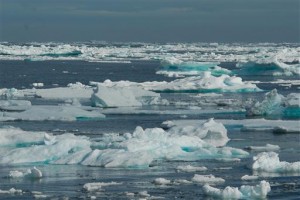Four Steps To Protect The Arctic, Our Final Ocean Frontier
 As summer sea ice disappears, Big Oil, commercial fishing, shipping and other industries have set their sights on the Arctic as a new source for profits. So far, mismanagement of virtually every other ocean on the planet has led us to a brave new world of collapsing fisheries, massive dead zones, huge floating garbage patches and destroyed habitats. The Arctic Ocean — long protected by a blanket of ice and now on the brink of major new development — might be our last chance to get oceans management right.
As summer sea ice disappears, Big Oil, commercial fishing, shipping and other industries have set their sights on the Arctic as a new source for profits. So far, mismanagement of virtually every other ocean on the planet has led us to a brave new world of collapsing fisheries, massive dead zones, huge floating garbage patches and destroyed habitats. The Arctic Ocean — long protected by a blanket of ice and now on the brink of major new development — might be our last chance to get oceans management right.In late February, I had the opportunity to speak at the World Oceans Summit in Singapore, an international conference hosted by The Economist. Hundreds of government officials, business leaders, scientists and activists came together to address our biggest ocean challenges. I came away from the meeting feeling more than ever that we need bold, daring, and achievable solutions to conserve and protect this remarkable and unique ocean, and the wildlife and people who depend on it.
With sea ice rapidly disappearing, the Arctic faces expanded fishing, offshore oil and gas development, and shipping. These activities always bring huge risks for ocean wildlife, including spills, invasive species, pollution, and disruptive underwater noise.
The Arctic is particularly vulnerable to these risks. Take offshore oil, for example, and think back to the 2010 BP oil disaster in the Gulf of Mexico. Despite occurring in perhaps the most well prepared region on Earth for a major oil spill, only a tiny percentage of the 170 million gallons of toxic crude oil that spewed into the water was ultimately captured and cleaned up. Now imagine a similar disaster taking place in the Arctic, with raging ice storms, blinding fog, darkness for months at a time, winds at hurricane force, and heaving chunks of broken sea ice. All that, and the nearest Coast Guard station more than 1,000 miles away. The results would be catastrophic, to say the least.
The Arctic is critical habitat for endangered and threatened species, including polar bears, whales, seals, and migratory birds. With sea ice melting and the water warming, these species are already under huge stress. Increased disruption could push these animals over the edge.
With the fate of the Arctic in the balance, what can we do about it?
We need a global effort, from government leaders in the eight Arctic nations (the U.S., Canada, Russia, Sweden, Iceland, Finland, Norway, and Denmark) and from all over the world, to balance industrial development with protection for this fragile region. And we can start with four key steps:
Protect key ecosystems: efforts have begun to identify ecologically and biologically significant areas in the Arctic marine environment. Protecting these areas can help maintain the resilience of Arctic marine ecosystems and the wildlife and people that depend on them.
Strict Arctic-Specific Standards: It’s no secret that the weather conditions, wildlife species, and infrastructure for disaster response are different in the Arctic than in other regions. Where development takes place, we need strict, uniform international standards for industrial activity that take into account unique Arctic conditions.
Ecosystem-Based Management: This means managing all the different human activities that will soon take place in the Arctic, from fishing to oil exploration to shipping, in an integrated way that addresses the combined impacts of multiple activities that affect the same ecosystem. It doesn’t do much good to protect a sensitive area from bottom trawl fishing, for example, only to see it destroyed by indiscriminate offshore mining.
Protection for the High Seas of the Central Arctic Ocean: Lying outside the jurisdiction of any country, the high seas of the central Arctic Ocean are an unexplored mystery. We know very little about what lives where, how the life there connects to ocean life in lower latitudes, whether fishing can occur safely and if so at what levels, and a myriad of other questions. Arctic coastal nations should agree to put the area off-limits to fishing, the most imminent extractive activity, until more is understood. Such an agreement would set an important precedent for the international community to protect and respect international waters of the Central Arctic Ocean.
What happens in the Arctic affects us all. Protecting this region from the destruction seen in our oceans worldwide is one of the most important tasks of our time. We need our government leaders to tackle huge Arctic challenges with big solutions, protecting the final ocean frontier on our planet.
You can return to the main Market News page, or press the Back button on your browser.

